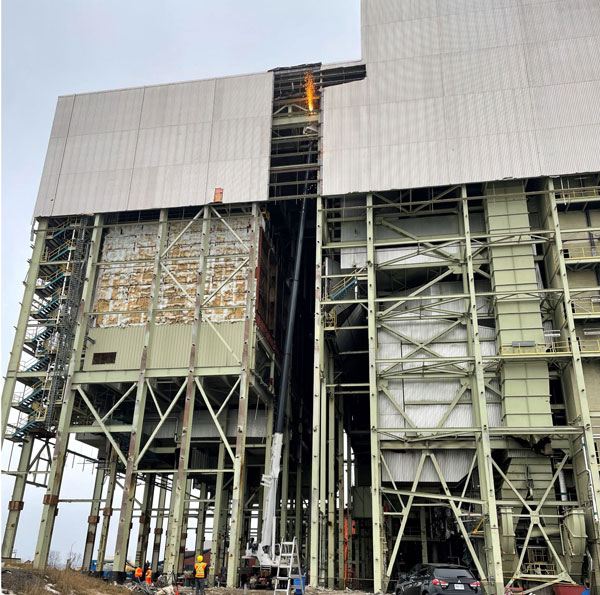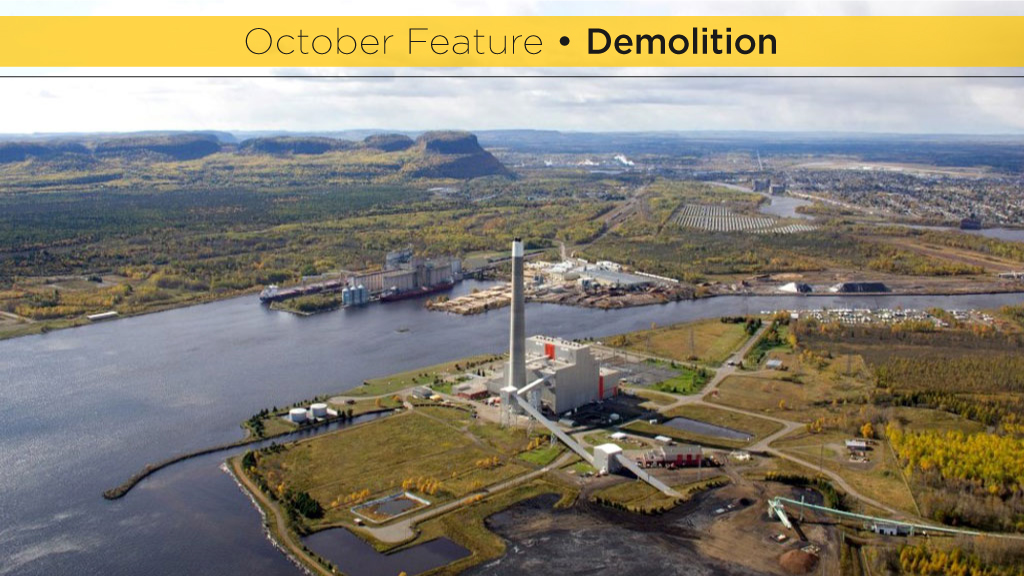After a year of planning and two years of carefully staged remediation and demolition, which included three separate implosions, Ontario’s last coal-fired generating plant is gone.
Mississauga, Ont.-based York1 is in the very final stages of the site cleanup of the former 326-MW three-boiler Ontario Power Generating Station in Thunder Bay.
Located on Mission Island on the shores of Lake Superior, it was the last of four plants that were closed and demolished as part of Ontario’s phase-out of coal-fired electricity generation. The others were Lakeview, Nanticoke and Lambton.
Unlike those other demolitions, which was overseen by OPG, this project was entirely managed by York1, says the company’s director of business development, Christina Murray.
After purchasing the site, York1 began initial planning in April 2020 and then began developing more detailed plans when its crews moved onsite exactly a year later, in April 2021.
In September, the first step in the demolition was completed with the blasting of the plant’s 198-metre-high concrete stack by Rakowski Energetics and Engineering. In the lead-up to that implosion, an extensive planning process was conducted with the input and participation of three separate engineering firms.
They included Englobe, the project engineer of record, blast engineer DSI, and ASI which conducted computer simulated tests to determine how the stack would react to the blast and wouldn’t prematurely fail, says Murray.
Some of the precautions included ensuring the stack would fall to the left and not to the right, which could have impacted an Ontario Hydro live switch substation. Any openings on the west side of the stack’s base had to be filled in with concrete and an opening had to be sawcut on the east side to allow it to collapse in that direction.
Favourable wind movements also had to be factored in, she says.

“The blast had to be completed when prevailing winds were moving away from the city towards Lake Superior. Water cannons were also stationed all around the base of the structure to mitigate the dust.”
Just as challenging were the subsequent second and third implosions, says Murray.
In the fall of 2021 the contractor and its consultants began planning for the blast separation of the precipitators from the boilers, a task which was completed later that year. Precipitators could be considered the dust filters of generating plants, she says.
“They use static electricity to remove soot and ash from exhaust fumes before they exit the smokestacks.”
Then, from December 2021 to June 2022, the contractor completed the blasting drop of two of the plant’s three 12-metre-high top hung boilers. This was no easy undertaking, as the boilers were hung from the roof by a series of steel I-beams. The third boiler was removed by shears and other equipment, she says.
Asked if the three implosions were timed at different intervals to minimize the impact on the site, Murray explained they were sequenced to allow for the preparation of each section.
“The stack had to be out of the way before the precipitators could be dropped and the precipitators had to be out of the way before the boilers could be dropped.”
Apart from the three implosions, there was a considerable effort to dismantle the remaining sections of the plant, a task which included a combination of manual labour and machines. There were approximately seven to eight excavators onsite, including a 750 Volvo High Reach, a 750 Volvo with a second-member shear, plus various support pieces, like loaders and skidsteers, says Murray.
Approximately 50 workers were involved in the abatement process and between 10 to 12 in the demolition, says demolitions operations director Jeremy Later.
“There were no lost time injuries,” says Later, who attributes that safety record to measures which included 200 site orientations, 1,000 daily hazardous assessments, 200 safety talks, and 10 equipment and jobsite inspections.
Securing employees, notably skilled equipment operators, and transporting some of the more sophisticated machines from the Toronto area to Thunder Bay was a planning and logistical challenge in itself, he says.
In a project PowerPoint presentation delivered to the World Demolition Summit in Toronto in October, Murray and Later pointed out that distance is roughly equivalent to the distance from London, England to Vienna, Austria.
The project is different from other demolitions in that York1 purchased the site and that’s a fact Murray readily concedes.
“We saw the potential of developing the site for industrial uses.”
At this point, the contactor is still exploring options on whether it would assume the role of a developer, sell the site, or partnering with a more traditional developer, she says.



Recent Comments